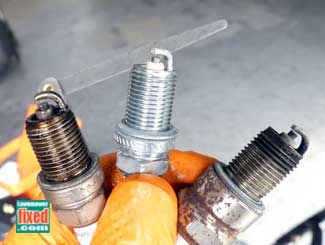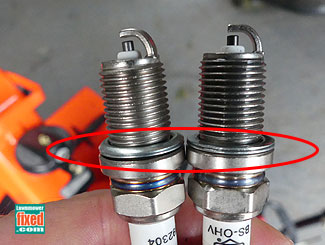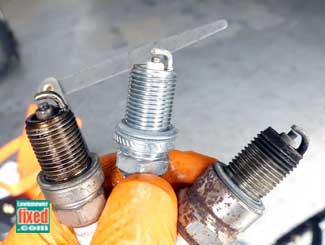In this article, we will discuss the importance of regularly changing the spark plug in your snowblower. We will provide you with useful information on how often you should do this maintenance task to ensure your snowblower runs smoothly. By the end of this article, you will have a clear understanding of the recommended frequency for changing the spark plug in your snowblower, helping you maintain its optimal performance. So, let’s get started and learn how to keep your snowblower running efficiently throughout the winter season.
Importance of Spark Plugs in Snowblowers
In order to maintain proper snowblower performance, it is crucial to understand the importance of spark plugs and their role in the functioning of snowblowers. Spark plugs play a vital role in creating the spark that ignites the fuel mixture in the combustion chamber of an engine. This ignition is what allows the engine to start and run effectively. Without a properly functioning spark plug, the snowblower may experience a range of performance issues.
Role of Spark Plugs in Snowblowers
Spark plugs are responsible for creating the spark that ignites the air and fuel mixture in the engine’s combustion chamber. When the piston moves to the top of its stroke, the spark plug provides an electric spark that ignites the compressed air-fuel mixture, resulting in the combustion process that powers the engine and propels the snowblower forward.
Effects of Worn-out Spark Plugs on Snowblower Performance
As spark plugs wear out over time, their performance degrades. Worn-out spark plugs may struggle to provide a strong, consistent spark, which can lead to poor ignition and misfires. This can result in a snowblower that is difficult to start, runs rough, experiences a loss of power, or runs less efficiently.
Factors Affecting Spark Plug Lifespan
Several factors can affect the lifespan of spark plugs in snowblowers. Understanding these factors can help determine how often spark plugs should be replaced.
Quality and Type of Spark Plug Used
The quality and type of spark plug used in a snowblower can significantly impact its lifespan. Premium, high-quality spark plugs will generally last longer than lower-quality alternatives. Additionally, using the correct type of spark plug recommended by the snowblower manufacturer is essential for optimal performance and longevity.
Operating Conditions and Frequency of Use
Operating conditions and frequency of use also play a role in determining how often spark plugs should be replaced. Snowblowers used in heavy snowfall areas or for prolonged periods may require more frequent spark plug replacements due to the increased strain on the engine. Similarly, snowblowers that are not used frequently may still require more frequent spark plug replacements due to the potential for corrosion and buildup over time.

This image is property of www.lawnmowerfixed.com.
Recommended Spark Plug Replacement Frequency
To ensure your snowblower continues to run smoothly and efficiently, it is recommended to follow the manufacturer’s guidelines for spark plug replacement. These guidelines can typically be found in the snowblower’s manual and are based on the specific model and engine type. It is important to note that these guidelines are general recommendations, and certain operating conditions may warrant more frequent spark plug replacements.
Signs Indicating the Need for Spark Plug Replacement
Aside from following the manufacturer’s guidelines, there are certain signs to look out for that may indicate the need for spark plug replacement. If the snowblower is becoming increasingly difficult to start, running rough, experiencing a loss of power, or showing signs of poor fuel efficiency, it may be time to check and replace the spark plug. Additionally, if the spark plug appears visibly worn, corroded, or damaged, replacement is necessary.
Steps to Replace Spark Plug in a Snowblower
Replacing a spark plug in a snowblower is a relatively simple process that can be done with a few basic tools and minimal technical knowledge. Follow these steps to replace the spark plug in your snowblower:
Gather Necessary Tools and Materials
Before starting, gather the necessary tools and materials, which typically include a spark plug socket, socket wrench, and a new spark plug that matches the specifications recommended by the snowblower manufacturer. Refer to the snowblower’s manual for the specific socket size and other details.
Locate the Spark Plug in the Snowblower
The spark plug is usually located on top of the engine, near the cylinder head. It may be covered by a spark plug wire or boot that needs to be removed to access the spark plug.
Disconnect Spark Plug Wire
The spark plug wire is connected to the spark plug with a boot or connector. Gently grasp the boot or connector and pull it away from the spark plug to disconnect it. Be careful not to pull on the wire itself, as this may damage it.
Remove the Old Spark Plug
Using the spark plug socket and socket wrench, loosen and remove the old spark plug by turning it counterclockwise. Once loose, carefully lift the spark plug out of the engine.
Inspect and Clean the Spark Plug Area
With the old spark plug removed, inspect the area around it for any debris, carbon buildup, or other contaminants. Use a soft brush or compressed air to clean the area if necessary, taking care not to let any debris fall into the spark plug hole.
Install the New Spark Plug
Before installing the new spark plug, check the gap to ensure it matches the specifications recommended by the snowblower manufacturer. The gap can usually be adjusted by gently bending the ground electrode. Once the gap is correct, carefully insert the new spark plug into the spark plug hole and hand-tighten it clockwise. Use the spark plug socket and socket wrench to tighten the spark plug further, but be cautious not to overtighten it.
Reconnect Spark Plug Wire
Once the new spark plug is securely in place, reconnect the spark plug wire by pushing the boot or connector onto the spark plug until it clicks into position.
Test the Snowblower’s Performance
With the spark plug successfully replaced, start the snowblower and observe its performance. If it starts easily, runs smoothly, and exhibits improved power and fuel efficiency, the spark plug replacement was successful.

This image is property of www.lawnmowerfixed.com.
Choosing the Right Spark Plug for Your Snowblower
When selecting a new spark plug for your snowblower, it is important to ensure that you choose the correct type and size. There are various types and sizes of spark plugs available, and using the wrong one can have a negative impact on performance and potentially damage the engine.
Different Types and Sizes of Spark Plugs
Snowblowers may require different types and sizes of spark plugs depending on the engine specifications. Common types include standard plugs, resistor plugs, and platinum plugs. It is crucial to consult the snowblower’s manual or contact the manufacturer to determine the exact spark plug requirements.
Considerations for Selecting the Correct Spark Plug
When choosing the correct spark plug for your snowblower, consider factors such as the engine size, spark plug heat range, and electrode design. These factors directly impact the spark plug’s ability to ignite the air and fuel mixture effectively and maintain proper engine performance. It is always best to use the spark plug recommended by the snowblower manufacturer to ensure compatibility and optimal performance.
Maintenance Tips for Spark Plugs in Snowblowers
Regular maintenance of spark plugs in snowblowers can significantly extend their lifespan and ensure proper engine performance. Consider the following tips to keep your spark plugs in optimal condition:
Regular Cleaning and Inspection
Periodically remove the spark plug and visually inspect it for wear, damage, or corrosion. Use a soft brush or compressed air to clean any debris or carbon buildup around the spark plug and the surrounding area. Regular cleaning and inspection can prevent fouling and ensure optimal spark plug performance.
Proper Gap Adjustment
Check and adjust the spark plug gap as recommended by the snowblower manufacturer. The correct gap ensures the spark plug’s ability to effectively ignite the air and fuel mixture. Use a spark plug gap tool or feeler gauge to measure and adjust the gap if necessary.
Preventing Fouling and Carbon Buildup
To prevent fouling and carbon buildup on spark plugs, it is essential to use high-quality fuel and regularly change the oil and air filters. Additionally, avoid prolonged idling or low-speed operation, as this can lead to incomplete combustion and carbon deposits on the spark plug electrodes.

This image is property of www.lawnmowerfixed.com.
Common Spark Plug Problems in Snowblowers
Understanding common spark plug problems in snowblowers can help identify issues and take appropriate action to rectify them. Some common spark plug problems include:
Misfiring or Failure to Start
If a snowblower is misfiring or fails to start altogether, it may be due to a faulty spark plug. A worn-out or dirty spark plug can result in weak or no spark, which prevents proper ignition and combustion. In such cases, the spark plug should be inspected and replaced if necessary.
Poor Fuel Efficiency
A snowblower that is experiencing decreased fuel efficiency may have a spark plug problem. A faulty or inefficient spark plug can lead to incomplete combustion, resulting in wasted fuel and decreased overall efficiency. Regular spark plug maintenance can help improve fuel efficiency and optimize snowblower performance.
Engine Performance Issues
Spark plug problems can also manifest as engine performance issues, such as rough running, a loss of power, or stalling. These issues may be caused by a spark plug that is not providing a consistent, strong spark. In such cases, checking and replacing the spark plug can help resolve the engine performance issues.
Benefits of Timely Spark Plug Replacement in Snowblowers
Timely spark plug replacement in snowblowers offers several benefits that impact both performance and longevity. Some of these benefits include:
Improved Engine Performance and Fuel Efficiency
By replacing worn-out or faulty spark plugs, the snowblower’s engine performance and fuel efficiency can be significantly improved. A properly functioning spark plug ensures a strong, consistent spark that leads to efficient combustion and optimal power output.
Prevention of Bigger Snowblower Problems
Failing to replace spark plugs at the recommended intervals can lead to more significant snowblower problems down the line. Ignoring spark plug maintenance can result in engine damage, decreased fuel efficiency, and costly repairs. Regular spark plug replacement can help prevent these issues and extend the overall lifespan of the snowblower.

This image is property of img.ehowcdn.com.
Spark Plug Replacement Services
When it comes to spark plug replacement, snowblower owners have two options: DIY replacement or professional servicing. The choice between the two depends on the individual’s mechanical skills, comfort level, and access to tools. DIY spark plug replacement can save money and be relatively straightforward for those familiar with snowblower maintenance. However, if unsure or inexperienced, it may be best to seek professional servicing to ensure the spark plug is replaced correctly and to avoid any potential damage to the snowblower.
Conclusion
In conclusion, the spark plug plays a crucial role in the overall performance and longevity of a snowblower. It is important to understand the significance of spark plug maintenance and replacement to ensure optimal engine performance and fuel efficiency. By following the manufacturer’s guidelines for replacement frequency and practicing regular spark plug maintenance, snowblower owners can enjoy a well-functioning machine that is ready to tackle any winter storm.

This image is property of i.ytimg.com.
